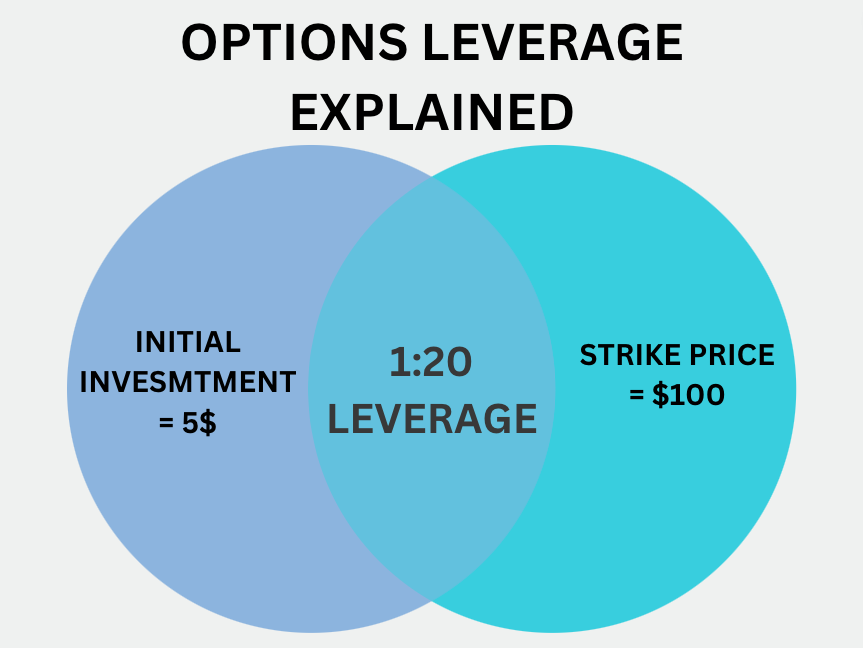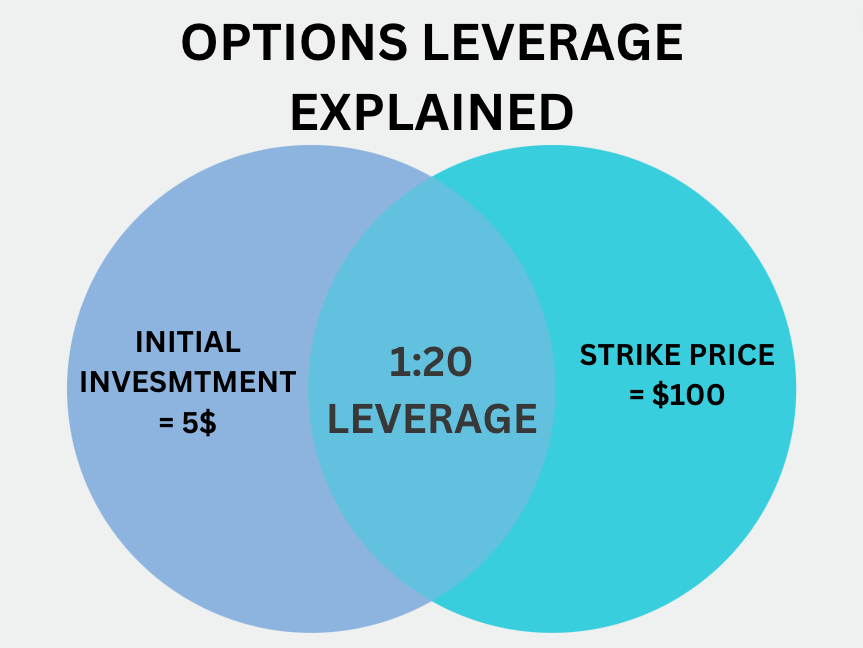Options leverage is one way to increase your buying power when buying stocks and it is a type of leverage product where you can maximize gains while keeping your risk 100% under control.
Most beginner traders see options trading as a complicated high-risk strategy that involves accurate market predictions and a lot of difficult terminology such as gamma, strike price, in-the-money, and of course your ratio.
But what is exactly leverage in options trading and how does it work?
More importantly, how is it possible that options trading offers outsized return potential while keeping your risk at a minimum?
In this guide, we’ll explain the basics of options trading, from how options provide credit, and some real-world examples to give you a better picture.
Key takeaways
- Options leverage allows traders to trade stocks with larger position sizes with less capital, offering the potential for larger returns while keeping risks limited to the premium paid.
- Successful leveraging of options requires a good understanding of market dynamics, option valuation, and strategic execution.
- Learning the role of margin and leverage is crucial in options trading where margin serves as collateral for potential losses, especially in complex strategies like writing options.
What is options leverage and how does it work?

Options leverage allows you to buy more expensive stocks than you can afford with your initial investment.
Let’s say that you want to buy a stock that is worth $100 but you only have $5 in your account, with credit you could buy a call option worth $5 and still get the $100 market exposure.
This options trade would give you a 1:20 multiplier because the $100 stock is worth 20 times more than the $5 you have deposited into your account.
Now if your prediction is correct and the stock price goes from $100 to $150 you would make a profit of $50.
That is 10 times more than your initial investment of $5.
This is the effect leverage has on profits from whether you are trading perpetual swaps or options.
When you buy an option, you are buying the right, but not the obligation, to purchase a stock at a specified price within a certain period.
If you believe the price of a stock will rise you buy a long option, called a call option.
If you believe the price of a stock will fall you buy a short option, called a put option.
This way you can short-sell with margin using options.
The multiplier in options comes from how they are priced, which is called the strike price.
Why do options give leverage?
Options provide leverage to traders for traders to afford to buy expensive stocks at a cheaper price, much like the same reason why leverage trading in any other market exists.
Since options are derivatives products that are derived from underlying assets and based on several different factors such as:
- Current stock price
- Strike price
- Time to expiration
- Implied volatility (IV)
- Interest rates
Options give different amounts of multiplier based on how these factors are combined.
Let’s say that a stock is trading a $100 per share. Instead of buying 100 shares for $10,000, you can buy a call option instead.
The strike price for these options is $100 for a premium of $5 per share and one option contract (which represents 100 shares) costs $500.
Now, with your $10,000 you can buy 20 contracts and control 2000 shares.
Should the stock rise to $120 which lets you sell the call option in-the-money with a $20 gain per share.
After having paid the $5 premium per share, your net gain is $15 per share.
And since each contract nets $1500 (100 shares x $15), totaling $30,000 for 20 contracts, yielding a $20,000 profit.
That explains how options give credit by allowing you to purchase more stock for a smaller amount.
Be aware though, that should the stock stay at $100 or fall, your option will expire worthless and you lose the entire $10,000.
Another incentive why brokers offer leverage in options is the same as for any other broker, increased spread costs and increased commissions.
The role of margin explained
Margin in options trading is another important concept that you need to take into consideration.
Your margin, or your margin requirement, is your deposited money.
The margin is used as collateral for your options strategies and is the fund in your account that will cover potential losses.
When buying options (calls or puts), the margin is the cost itself for the option, also called the premium.
You could say that it is a form of security for the broker, much like the amount you have to put up when placing a bet while gambling with the difference that leverage trading is not considered gambling.
You either make a profit or lose the entire margin stake.
When you are selling options, the game changes, and the risk factor increases.
If you are selling options, especially naked options, you need a large sum of money to cover the nearly unlimited loss potential should the market go against you.
Margin and credit work hand-in-hand in options trading and one can not exist without the other.
The margin allows you to enter a position, and credit allows you to amplify the position size.
Finding out your ratios
The formula for calculating options leverage is straightforward:
Ratio = (Underlying Asset Price / Option Premium) x Delta
Explanation
The ratio is found out by dividing the price of the stock by the option premium and multiplying the option’s delta.
Delta, a “Greek” used in options pricing, represents how much an option’s price changes for every $1 change in the stock.
If you use a high multiplier it means a greater sensitivity to the price movement of the stock.
In other cases, use our leverage calculator to figure out the correct ratio.
Profit and loss, how are they connected?
Due to how credit is applied to options trading it can create situations with very profitable scenarios as well as highly risky and the losses with leverage can mount up quickly if you are not careful.
In this section, I’ll go through some profit and loss scenarios that are common in options trading.
Profit scenarios:
- In-the-money options: Options that are “in-the-money” means that the price has moved favorably to the strike price. For a call option, this means that the market price is above the strike price at which you bought the options. For a put option, this means that the market price has fallen below the strike price at which you bought the option. The profit you make from options is the difference between the current market price and the strike price, minus the premium you paid for the option. Because of leverage in options trading, this profit can be 2x, 10x, or even 50x larger than the initial investment.
- Selling options before expiration: It is very common for options traders to sell their options for a profit before expiry if it is “in-the-money”. If volatility has pushed the market price in a favorable way past your strike price, it can be sold at a premium that is higher than the purchase price generating a profit based on the difference again.
Loss scenarios:
- Out-of-the-money options: Opposite to an “in-the-money” option, an “out-of-the-money” option will expire worthless because the underlying market price didn’t move past the strike price. If you bought a call option, this means that the market price is lower than the strike price you paid. For a put option, this means that the market price is still higher than the strike price you paid. The difference here compared to when borrowed capital is applied to a profitable options trade is that the trader only loses the premium paid, let’s say $50. There is no credit added to the losses of an option.
- Time decay: Since options are time-sensitive trading instruments, the value of the option can decrease as the expiration date gets closer. This phenomenon is known as time decay, meaning that an option can become less valuable day by day and it could lead to a loss even if the underlying asset moves in the expected direction but not fast enough.
- Assignment risk on short options: When selling options, also called writing options, there’s a risk of assignment where the option buy who is on the other side of the trade exercises their right. Should the market move in the opposite direction for the option writer (the seller), the writer may fall into significant losses. This is particularly dangerous when selling short call options where the loss can be unlimited.
In comparison to traditional trading, options trading doesn’t impose risks such as a margin call or liquidation.
Look at these examples, it will teach you the story
To explain further how leverage works in options trading I’m going to give you a practical example.
This is an example for a long position (buying a call option).
Buying a call option example:
Let’s say we have a stock called TechCorp trading a $100 per share and you think that the stock is going to release positive earnings reports during the next month which might cause a breakout in the price.
Now, instead of going to your stock broker and purchasing the stock outright, you decide to buy a call option with a strike price of $100 which expires in two months.
The option costs $10 per share and each contract is worth 100 shares making your total investment worth $1000.
Let’s see how this could play out in the real world.
The positive scenario where you make a profit is where TechCorp rises to $120 after a positive earnings report and your call option is well in-the-money.
You can now sell your option and sell them at the market price of $120 generating a profit of $2000.
The profit comes from the $20 gain per share on all of your 100 shares that you bought through the option.
After deducting the cost of your initial investment ($1000), your net profit is $1000.
On the negative side, should TechCorp’s stock fail to meet the earnings report and fall, and is below the strike price at the expiration, your option will expire worthless and you would take a 100% loss on the $1000 investment.
Keep in mind that with options, you don’t pay back the leverage used like with standard contracts.
Instead, the credit is paid upfront when paying the premium.
Leverage explanation:
The ratio in this example can be found out by comparing the return on investment of the option position to the return on investment of a direct investment in the stock.
- Direct Stock ROI = ((Stock’s Final Price – Stock’s Initial Price) / Stock’s Initial Price) * 100%
- Direct Stock ROI = (($120 – $100) / $100) * 100% = 20%
- Ratio = Option Position ROI / Direct Stock ROI
- Ratio = 100% / 20% = 5
In this example, the ratio turned out to be 1:5 which is a good leverage for a $1000 account.
What are the pros and cons?
Options leverage has several benefits but also some notable drawbacks that beginners should be aware of before testing it with real money.
Let’s start by looking at the pros:
- High profit potential: Options can yield windfall profits even with a small investment if the ratio is high enough.
- Low initial investment: Options give you the freedom to control a much larger position size with a smaller amount of capital making it possible to size up significantly.
- Flexible trading strategies: There are over 400 different options strategies to use which gives the trader great flexibility in all market environments.
- Hedging: Options can help you hedge against adverse market movements in other investments.
- Access higher-priced stocks: With options, you can buy higher-priced stocks with a smaller account size.
Here are the cons:
- High risk for high loss: Even small market moves can increase the risk with leverage from options.
- Complex for beginners: Options are relatively complex and beginners usually find them difficult to understand.
- Time decay (theta): Options have an expiration date and their values usually decrease as this date approaches which is called time decay. Sometimes, even if your price is stable, the options can expire worthless due to time decay.
- Potential for a total loss of invested capital: You always run a risk of losing 100% of the premium paid if the option expires worthless.
- Volatility impact (vega): Options are sensitive to the volatility of the underlying asset. If the volatility shrinks for the underlying asset it can lead to a decrease in the value of the option.
- The margin requirement for writing options: For those who are writing options (selling options to others), margin requirements can be extremely big. Also, the potential for unlimited loss of the margin is always a possibility.
Conclusion
In this article, we have discussed options leverage and how it brings both exceptional profit opportunities for traders but also high risk of loss and complexity for beginners.
We’ve covered all the angles explaining how leverage is applied to options, how it can be used profitably, and what happens when you lose.
You will learn that to succeed in options trading your main focus should be on mitigating risk by choosing an options contract with the correct ratio.
Whether you are using options as a hedging tool or as a way to speculate on highly-priced stocks, it demands respect and knowledge.
This guide will give you a complete understanding of the basics how how leverage is used in options.


